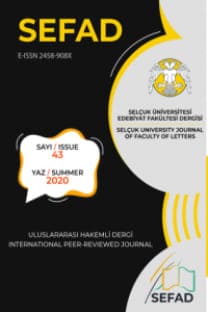Toylukta Bir Çıraklık: Bir Anti-Bildungsroman Örneği Olarak Witold Gombrowicz’ten Ferdydurke
Bu makale, Witold Gombrowicz’in 1937 yılında Polonya’da yayımlanmış olan romanı Ferdydurke’ün klasik Bildungsroman türünü biçimsel ve tematik olarak alaşağı ettiğini tartışır. Bildungsroman türünün yayılmasını sağlayan eser, Goethe’nin çığır açıcı romanı Wilhelm Meister’in Çıraklık Yılları’dır (1795). Çoğunlukla bir öz-oluşum anlatısı olarak değerlendirilen Bildungsroman türü, on sekizinci yüzyıl Almanya’sında, hümanizm çağında ortaya çıkmış olup, bireyin toplumla uyumlu bir şekilde birleşmesine vurgu yapar. Bu toplumsal amaç, estetik idealizmin parçalar ve bütünün organik birliği üzerine modellenmiş biçim anlayışına da taşar. Bu makale, Ferdydurke ve Wilhelm Meister’in Çıraklık Yılları romanlarını karşılaştırır ve Ferdydurke’ün Bildungsroman’ın “güzel bütünlük” anlayışını grotesk bir parça estetiği aracılığıyla sarsarak, bu estetiğin Birinci Dünya Savaşı’nın sonrasında ve ikincisinin eşiğinde çökmüş olan toplumsal uyumu anıştırdığını iddia eder. Gombrowicz’in insanlararası düşmanlığın çökeltisini yansıtan özgün Biçim anlayışı, Ferdydurke’te vücut bulmuştur. Roman da kahramanı gibi bölümleri arasına yerleştirilmiş manifestolar, kuramsal düşünüşler, anlatıdan sapmalar ve bu sapmalara yazılmış önsözler aracılığıyla kendi biçimsel olgunluğunu sekteye uğratır. Bakhtin’in dediği gibi, Bildungsroman, oluşum sürecindeki insanın imgesini sunuyorsa, Ferdydurke bu sürecin çözülümünü kendi biçimi aracılığıyla gerçekleştirir.
Anahtar Kelimeler:
Bildungsroman, Gombrowicz, bildung, modernizm, Ferdydurke
An Apprenticeship in Immaturity: Witold Gombrowicz’s Ferdydurke as an Anti-Bildungsroman
This article argues that Ferdydurke, Witold Gombrowicz’s novel published in 1937 in Poland, formally and thematically subverts the classical Bildungsroman. The seminal novel that has propagated the Bildungsroman genre is Goethe’s Wilhelm Meister’s Apprenticeship (1795). Bildungsroman, commonly understood as a narrative of self-formation, was conceived in Germany in the late eighteenth century in the age of humanism and emphasizes the harmonious integration of the individual with society. This social mission also carries over to aesthetic idealism’s notion of form, which is modeled on the organic unity of parts and the whole. Comparing Gombrowicz’s Ferydurke with Goethe’s Wilhelm Meister’s Apprenticeship, the article contends that Ferdydurke displaces Bildungroman’s notion of “beautiful totality” by a grotesque aesthetics of parts that alludes to the collapse of harmonious social relations in the aftermath of the First World War, and on the threshold of the Second. Gombrowicz’s unique articulation of Form as the sedimentation of interpersonal antagonism is embodied in Ferdydurke, which, much like its protagonist, sabotages its own formal maturation through manifestoes, theoretical reflections, narrative digressions, and prefaces to the digressions thrown between the chapters. If the classical Bildungsroman presents us with the image of man in the process of becoming as Bakhtin has argued, Ferdydurke enacts the dissolution of that process in its very form.
Keywords:
Bildungsroman, Gombrowicz, bildung, modernism, Ferdydurke,
___
- ADORNO, Theodor (2004). Aesthetic Theory. trans. Robert Hullot-Kentor. Minneapolis: University of Minnesota Press.
- BAKHTIN, Mikhail (1986). “The Bildungsroman and Its Significance in the History of Realism”. Speech Genres and Other Late Essays. trans. Vern W. McGee. Austin: University of Texas Press.
- BOLECKI, Wlodzimierz (1999). “Post-Modernising Modernism”. From Norwid to Kantor: Essays on Polish Modernism. eds. Grazyna Bystydzienska and Emma Harris. Warsaw: Warsaw University Press
- EVER, Selin (2013). The Modernist Bildungsroman: End of Forms Most Beautiful. Doctoral Dissertation. Durham: Duke University.
- FREUD, Sigmund (1957). The Standard Edition of the Complete Psychological Works of Sigmund Freud. Vol. 14. trans. James Strachey. London: Hogarth Press
- GODDARD, Michael (2010). Gombrowicz, Polish Modernism, and the Subversion of Form. Indiana: Purdue University Press.
- GOETHE, Johann Wolfgang Von (1995). Wilhelm Meister’s Apprenticeship. trans. Eric A. Blackall. Princeton: Princeton University Press
- GOETHE, Johann Wolfgang Von (2009). The Metamorphosis of Plants. Cambridge: MIT Press.
- GOMBROWICZ, Witold (1973). A Kind of Testament. trans. Alastair Hamilton. Philadelphia: Temple University Press.
- GOMBROWICZ, Witold (1988). Diary Volume I. trans. Lillian Vallee. Evanston: Northwestern University Press.
- GOMBROWICZ, Witold (2000). Ferdydurke. trans. Danuta Borchardt. New Haven: Yale University Press.
- HEGEL, Georg Wilhelm Friedrich (1986). Lectures on Fine Arts. trans. T. M. Knox. Oxford: Clarendon.
- JAMESON, Fredric (1986). “Third-World Literature in the Era of Multinational Capitalism”. Social Text. No 15. pp.65-88.
- JAMESON, Fredric (2007). “A Note on Literary Realism in Conclusion”. Adventures in Realism. ed. Matthew Beaumont. Oxford: Blackwell Publishing.
- KANT, Immanuel (2001). Critique of the Power of Judgment. trans. Paul Guyer. New York: Cambridge University Press.
- KONTJE, Todd (1993). The German Bildungsroman: History of a National Genre. Camden House Publishing.
- LUKACZ, Georg (1969). Goethe and His Age. trans. Robert Anchor. New York: Universal Library.
- LUKACZ, Georg (1993). German Realists in the Nineteenth Century. trans. Jeremy Gaines and Paul Keast. Cambridge: The MIT Press.
- MORETTI, Franco (1987). The Way of the World: The Bildungsroman in European Culture. trans. Albert Sbragia. London: Verso.
- MÜLLER-SIEVERS, Helmut (1997) Self-Generation: Biology, Philosophy, and Literature Around 1800. Stanford: Stanford University Press.
- SCHILLER, Friedrich (2003). “Kallias or Concerning Beauty: Letters to Gottfried Körner”. Classic and Romantic German Aesthetics. ed. J. M. Bernstein. Cambridge: Cambridge University Press.
- SCHILLER, Friedrich (2004). On the Aesthetic Education of Man. trans. Reginald Snell. New York: Dover Publications.
- Yayın Aralığı: Yılda 2 Sayı
- Başlangıç: 1981
- Yayıncı: Selçuk Üniversitesi Edebiyat Fakültesi
Sayıdaki Diğer Makaleler
Raymond Carver’in A Small, Good Thing Adlı Hikâyesinde Eşduyum Duygularının Etkinleştirilmesi
Afyon Gedik Ahmet Paşa Cami Taçkapısı
Sıradanlaşmaya Karşı Direniş: The Wooster Group
Eleştiri Kültürünün Konya Türkülerine İz Düşümü
Erzurumlu Darîr’in Sîretü’n-Nebî Adlı Eserinden Eski Anadolu Türkçesinin Söz Varlığına Katkılar
Orhan YAVUZ, Fatih Numan KÜÇÜKBALLI
Toylukta Bir Çıraklık: Bir Anti-Bildungsroman Örneği Olarak Witold Gombrowicz’ten Ferdydurke
Avrupa’da Âşıklık Geleneğinin İcrası ve Bu Geleneği ‘Geleceğe’ Taşımanın Yolları
Yazı ve Benlik: John Fowles’ın Kurgu Dışı Otobiyografik Yazıları
Börükçü’den Bir Grup Siyah Figürlü Lekythos
16. ve 20. Yüzyıl İspanyol Romanında Anti-Kahramanın Gelişimi
